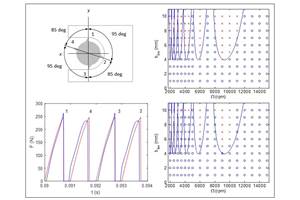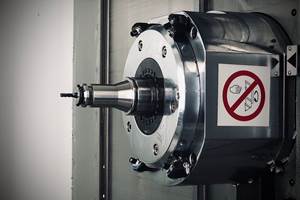Tooling Reduces 21 Minute Job To 9 Minutes
Shop leadership was looking for a way to reduce the time it took to complete a very difficult boring job. The job took 21 minutes per part to complete with multiple roughing and finishing processes. It required 10 minutes of hone time.
Share





Hommer Tool and Manufacturing Company (Arlington Heights, Illinois) employs about 40 people. Its equipment includes six CNC lathes, one CNC machining center, grinding, honing and wire EDM equipment. The company emphasizes precision processes and quality workmanship. It accepts mostly shorter run jobs with tight tolerances, many for the injection molding industry.
James "JR" Hommer, vice president, was looking for a way to reduce the time it took to complete a very difficult boring job. The job took 21 minutes per part to complete with multiple roughing and finishing processes. It required 10 minutes of hone time.
The material used for the cylindrical workpiece was Inconel, a strong, resilient aerospace alloy that can be tough to machine. Hommer Tool, a job shop specializing in close tolerance round tooling, had to remove 0.060 inch of material and keep tolerance within ± 0.0005 inch.
The diameter of the bore was 1.290 inches and the depth was 9 inches—a diameter to length ratio that would exceed any published standards, according to Mr. Hommer.
Application engineer Jeff Stone of KPT/Kaiser Precision Tooling, Inc. (Elk Grove Village, Illinois), and distributor Tom Senger, West Side Industrial Supply (South Elgin, Illinois), came up with a possible solution. They proposed dispensing with the honing operation and reducing the multiple roughing and finishing processes to a single, two-sided operation on a lathe using KPT/Kaiser's 10.315.301 twin cutter roughing head.
KPT/Kaiser twin cutters have not often been considered for applications on lathes, and Mr. Hommer had to be persuaded that the same tool would do both roughing and finishing within the tight tolerance. "No one had samples to prove the process," he says. "It was putting a lot of risk on me." On the other hand, none of Hommer's other tooling suppliers had a competitive bid for the job, so Mr. Hommer decided to take the chance.
Everyone was pleased with the results. "It cut a 21-minute job to 9 minutes" Mr. Hommer says. Considering that Hommer's contract called for producing 2,000 of these pieces for a military application, saving 12 minutes per piece meant significant cost reduction.
"We don't like to talk specific dollars, but we can say that Kaiser tooling helped to make this a profitable contract," Mr. Hommer says. "We used a carbide bar with coolant through," says Mr. Stone. "The bar length was 13.8 inches, long enough to cut a bore 12.1 inches deep. This is an in-stock item at KPT/Kaiser, where our competition was quoting specials."
"Running a twin cutter on a lathe requires much closer attention to setup detail than in rotating tool applications," Mr. Stone adds. "We have to align the inserts parallel to the ways of the machine. In this case, we were using one insert for roughing and the other side for finishing, making two operations with the same tool. The cutting edges of the inserts have to be positioned precisely on the centerline and the length of the tool must be precisely parallel to the centerline of the bore to be machined."
Hommer used a 11.654.968 TiAlN-coated insert. They roughed out 0.040 inch at 100 SFM/0.003 IPR and finished at 200 SFM/1.8 IPR, removing 0.020 inch of material.
"‘Never been done' has never been a term in our vocabulary," says Mr. Hommer. "We welcome new manufacturing challenges!"
Related Content
The Impact of Cutting Teeth Spacing on Machining Stability
Many cutter designs are available, and variable teeth spacing (or variable pitch) cutters can be used to influence milling stability. Let’s discuss why teeth spacing affects stability.
Read MoreBriquetting Manufacturer Tools Up for Faster Turnaround Times
To cut out laborious manual processes like hand-grinding, this briquette manufacturer revamped its machining and cutting tool arsenal for faster production.
Read MoreOrthopedic Event Discusses Manufacturing Strategies
At the seminar, representatives from multiple companies discussed strategies for making orthopedic devices accurately and efficiently.
Read MoreHow to Troubleshoot Issues With Tool Life
Diagnosing when a tool is failing is important because it sets an expectation and a benchmark for improvements. Finding out why gives us a clue for how to fix it.
Read MoreRead Next
Machine Shop MBA
Making Chips and 91±¬ÁĎÍř are teaming up for a new podcast series called Machine Shop MBA—designed to help manufacturers measure their success against the industry’s best. Through the lens of the 91±¬ÁĎÍř benchmarking program, the series explores the KPIs that set high-performing shops apart, from machine utilization and first-pass yield to employee engagement and revenue per employee.
Read MoreAMRs Are Moving Into Manufacturing: 4 Considerations for Implementation
AMRs can provide a flexible, easy-to-use automation platform so long as manufacturers choose a suitable task and prepare their facilities.
Read More





















